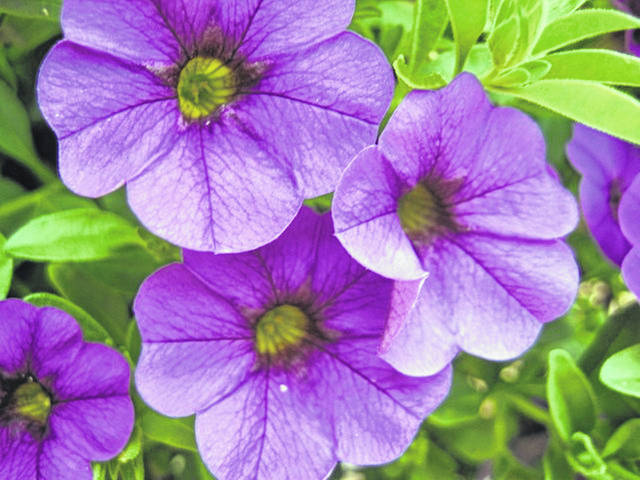

We’re finally past the danger of frost, but many of those perennial flowers aren’t yet in bloom. So you may want to think about adding instant color to your garden by planting annuals. Unlike perennials that come back year after year, annuals are plants that grow until frost or cold weather kills them. They add beauty to your landscape, they attract bees, butterflies, and hummingbirds, and they fill in those empty spaces better than mulch.
Some annuals, however, are much easier to grow than others, even for the inexperienced (or lazy) gardener. Each year, The Ohio State University conducts field trials of thousands of plants and is the only site in Ohio to participate in the All-America Selections to determine which varieties to recommend. To see results of OSU’s 2019 evaluation, go to www.go.osu.edu/fieldtrials. Meanwhile, here are a few suggestions for annuals that will give you the biggest bang for your buck but don’t require constant attention.
For Containers and Hanging Baskets in Sun:
Calibrachoa ‘Superbells’ ‘Million Bells’ – No deadheading on this colorful little cousin of petunia, but don’t plant it in the ground. It performs best in containers and hanging baskets. Remember to water it when it gets dry, and give it plenty of liquid fertilizer. If it starts getting leggy in late August, cut back a few of the stems each week, and fertilize some more. The color range includes almost every color except blue, and some varieties are double-petaled. Calibrachoas like full sun or light shade and moist soil. Use potting mix, not potting soil for best results.
For In-ground Planting in Sun:
Celosia ‘Arrabona Red’ – Definitely no dead-heading for this annual with blooms that looks like brilliant red candle flames! It takes heat and drought with no difficulty, and it lasts until the first frost. It can be started from seed or transplanted when small. The only danger is overwatering, so grow it where standing rain water is not a problem. It gets up to 15” tall and needs no staking.
For Containers in the Shade or Part Sun:
Coleus ‘Main Street Beale Street’ – Reviewers raved about the dark red leaves on this bushy annual that don’t bleach out or get spotty, even when they get too much sun. In fact, this coleus can be grown in the sun, too, if it gets enough moisture. Another plus is that it doesn’t flower until quite late in the season or sometimes, not at all. (Coleus is grown for colorful leaves, not flowers.) Plant this one with white ‘Diamond Snow’ or ‘Diamond Mountain’ euphorbia for a great contrast.
For Containers or In-ground Shade:
Impatiens ‘Rockapulco’ – This orange impatiens does as well in containers as it does in the ground. The bright orange double flowers cover the bushy plants as long as they are given plenty of moisture and are fertilized regularly. These Proven Winner impatiens are grown with a fungicide which protects them from the disease that affected impatiens in past years. It’s best, however, not to plant them in the same location year after year.
For Containers or In-ground Sun:
Ornamental Pepper ‘NuMex Twilight’ or ‘NuMex Easter’ – For something eye-catching and different, try growing ornamental peppers. They’re colorful and fun, even though they’re not edible…except for those with a penchant for mouth on fire. Both varieties can be started from seed or transplants and grow quickly to about 10” tall. The ‘Twilight’ variety features an abundance of purple, yellow, red, and orange peppers in clusters—all on the same plant and all at the same time. The ‘Easter’ variety has the same growth habit, but the colors are pastel: lavender, cream, pink, and peach.
For Containers or In-ground Sun or Part Sun:
Supertunia Vista ‘Snowdrift’ (pure white), ‘Bubblegum’ (pink), ‘Fuschia’ (deep pink), ‘Silverberry’ (white with red streaks in the center), ‘Indigo’ (purple with darker purple streaks in the center) – These are just some of the colors available in the Supertunia Vista series, and all of them perform beautifully without dead-heading in sun or part sun. Make sure to fertilize and water them regularly when the weather turns hot. Other than that, watch them spread and mound over their own leaves with outstanding color until a hard frost.
For In-ground Sun, Hot and Dry:
Vinca Pacifica ‘Pink’, ‘Rose Halo’, ‘Sunstorm Apricot’ – If you have an area that dries out quickly, even after a heavy rain, then any of the Vinca Pacifica series of flowers is a good choice. All you have to do with this flower is plant it in a sunny area, fertilize it every 2 weeks if you remember, and enjoy it. It blooms profusely all summer long and into fall.
For more ideas, suggestions, or questions, please contact a Shelby County Master Gardener by email at [email protected].



